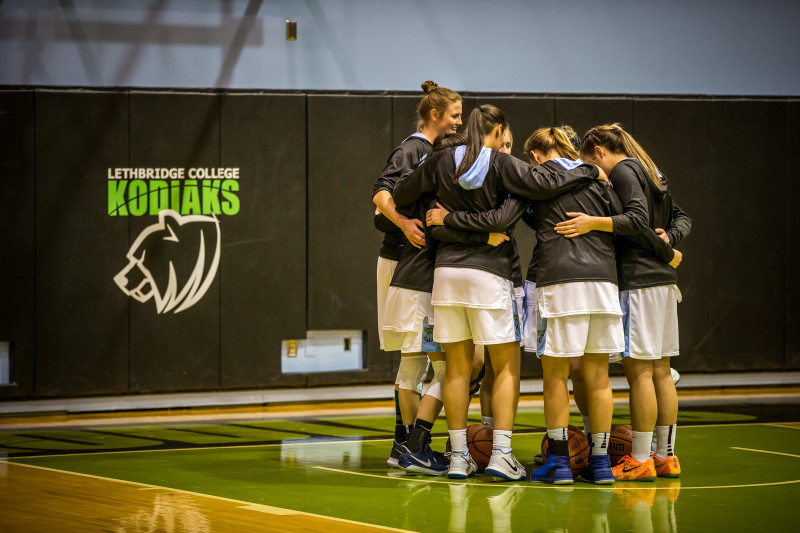
Third-year post Shayna Mathison uses her height to her advantage on the court. The towering athlete measures up at 6’1.
The high-tempo music vibrates the hardwood and the targeted intensity is palpable throughout the gymnasium.
Looking up at the stands to see the almost empty bleachers, the Kodiaks notice the deafening silence of another game played without a crowd. For many women’s sports, this is the far too frequent reality.
Deanna Dotts, head coach of the Lethbridge College Kodiaks Women’s basketball team, has spent years around the sport. She says empty seats are just an unfortunate reality females have come to expect over the years.
“Now it’s almost like the girls don’t notice the empty stands anymore because it’s normal and that part is not OK. We shouldn’t have to just accept that as how it is.”
codes=”true”]The passionate leader says although poor attendance is inevitable, it doesn’t stop her players from leaving everything on the court.
“You could be dominating and still have to beg people to come out to your game so we have just decided that we will give a show to the people that come out, and they’re going to be better off for it,” said Dotts.
Starting post Shayna Mathison mimics the sentiment put forth by her coach.
“It’s crazy to think that we won nationals last year but there is still more people that come out to the see the boys,” said Mathison.
Now in her second year with the Kodiaks, the towering athlete has witnessed unbalanced coverage for men’s and women’s sports far too often.
“Even around the school you see the men’s team on banners and the backs of magazines because they are holding provincials this year. Well, last year we hosted and never got any of that,” said Mathison.
Lethbridge College Communications specialist Paul Kingsmith says the College community works hard to ensure both women’s and men’s athletics receive equal opportunities but constantly battle age-old genders stigmas.
“Internally at the college there is no difference in excitement levels or the quality of the competition, but unfortunately it is a societal issue and we would be lying if we said it didn’t permeate, at least somewhat, into the games here,” said Kingsmith.
As a former journalist Kingsmith recognizes organizations such as the Kodiaks have their back against the wall, largely in part to the current make-up of the news industry.
“Media plays a huge role in any sort of narrative. In terms of sports a real awareness is needed on how they are presenting sports news to the world and not just leading with men’s games, but to critically think about why they are putting what news where.”
Kingsmith believes it’s bigger than just a best practice. “I think the media does have an opportunity, if not a responsibility to cover both genders sports evenly and equally. The media has to bridge that gap between men and women in sports.”
Dotts holds a similar viewpoint on the obligation broadcasters have to balance coverage.
“I think the change has to come from the media and reporters. You look at our team from last year, an undefeated national championship team, and it wasn’t until after we won that we got the recognition for what we were doing.”
In the 2016-2017 season the women’s team dominated the competition during the regular season, boasting a 21-0 record. At provincials, the Kodiaks were unstoppable juggernauts who captured the 13th ACAC championship in program history before continuing onto claim a national title.
Looking outwardly, the biased coverage is not limited to the halls of Lethbridge College.
According to ESPN statistics, the average WNBA game garners approximately 413,000 viewers, while one average 1.46 million tune into NBA games.
“I understand they have to worry about ratings, but someone has to push women’s basketball, women’s volleyball or women’s cross country because they work hard and they deserve the recognition too,” said Dotts.
Mathison believes there may be bigger issues at play.
“I once heard someone say about women’s soccer that if their shorts were shorter more people would come out and watch. That blows my mind because it’s so awful. People should be there to watch a sport not check out the length of someone’s shorts.”
Although the dominant player says she’s disheartened by the treatment of women in sports she is hopeful that things are changing.
Dotts says that the unfortunate thing is, supporters will tell girls that they can be anything, achieve everything if they just work hard, but the current sports climate will show them that’s not the case.
“I’m one of three female coaches in the ACAC women’s basketball division. So out of 15 teams, only three are led by women. There are opportunities out there, but I think sometimes it’s just harder to be a female in sports.”





